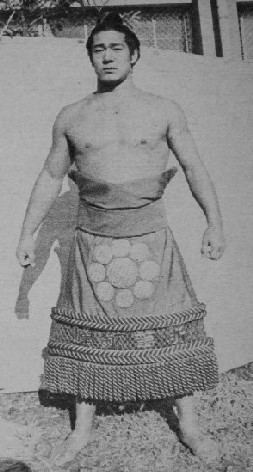Record 403-378-31 Championships 1 (Makushita) Height 1.78 m Debut May, 1961 Name Fujinokawa Takeo Weight 108 kg | Highest rank Sekiwake (May 1967) Role Sumo Wrestler Career start May 1961 Retired November, 1972 Makuuchi rank Sekiwake | |
 | ||
Special Prizes Fighting spirit (2)Outstanding performance (1)Technique (4) Similar People Kashiwado Tsuyoshi, Kotozakura Masakatsu, Mienoumi Tsuyoshi, Asahikuni Masuo, Kitanofuji Katsuaki | ||
Fujinokawa Takeo (born 26 September 1946 as Takeo Morita) is a former sumo wrestler from Otofuke, Hokkaido, Japan. He made his professional debut in May 1961 and reached a highest rank of sekiwake in May 1967. He was a runner-up in two top division (makuuchi) tournaments, finishing three wins behind Tamanoshima in May 1968 and losing a playoff to ozeki Kiyokuni in July 1969. He earned four kinboshi for defeating yokozuna and won seven special prizes. After his retirement in 1972 at the age of 26 he became an elder of the Japan Sumo Association and took over as head coach of Isenoumi stable in 1982. He left the Sumo Association in 2011 upon reaching 65 years of age.
Contents
Career
He joined professional sumo upon graduating from Takushoku University Daiichi High School in 1961. He initially wrestled under his own surname, Morita. He won the makushita division championship or yusho in November 1965 with a perfect 7–0 record. He reached the juryo division in January 1966 and the top makuuchi division in November 1966, one of the first wrestlers born after World War II to achieve this. One of his stablemates at Isenoumi stable was yokozuna Kashiwado Tsuyoshi. In just his third top division tournament March 1967 he defeated a yokozuna, earning his first kinboshi, won two special prizes for Outstanding Performance and Technique, and scored 12 wins against three losses. He was rewarded with promotion to the sanyaku ranks for the first time, at sekiwake. He was demoted after one tournament after scoring only 7–8 and only made the rank one more time in 1970, although he was ranked at komusubi on several other occasions. He was runner-up in two tournaments, in May 1968 (although he only scored 10–5) and July 1969 (after losing a play-off to Kiyokuni after both had finished on 12–3).
On the sixth day of the July 1971 he suffered an injury to his left leg in a match with Yoshinohana, which led to him withdrawing from the tournament and being demoted to the juryo division. He felt he had to return to action in the next tournament to win back his rank despite not being fully healed, and withdrew again. It was partly in response to his slump in form due to his injury that the Sumo Association introduced the kosho seido or public injury system, whereby a wrestler injured in competition could sit out the next tournament without an effect on his rank. Fujinokawa did eventually manage to return to the top division in July 1972 but withdrew once again during the following tournament in September 1972 and never fought again.
Retirement from sumo
He retired in November 1972 at the age of just 26, and after working as an assistant coach for some years under the elder name Tatekawa, he became Isenoumi Oyakata and head coach of the Isenoumi stable in December 1982 upon the death of the previous head, former maegashira Kashiwado Hidetake. He produced the top division wrestlers Kitakachidoki, Tosanoumi and Oikari. In February 2002 he was elected to the board of directors of the Japan Sumo Association. He commented about the suspension of Asashōryū in August 2007. He apologized to Japan's vice sports minister Kenshiro Matsunami on behalf of the Sumo Association over the case of Junichi Yamamoto in February 2008. He stood down from the board in February 2010. He was responsible for developing in 2011 questionnaires to assess the wrestlers' fighting spirit that are handed out to the public on tournament match days. On September 25, 2011, NHK's live sumo broadcast contained coverage of Isenoumi oyakata's retirement press conference. He announced that he would be turning 65 the following day and thereby reach the mandatory retirement age of a sumo coach. He named his replacement as head coach as Katsunoura Oyakata, the former Kitakachidoki.
